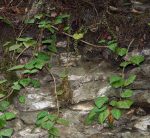 Native to the cloud forests, stream valleys and mountains of the Near and Middle East, this evergreen climbing shrub is a member of ginseng familia, Araliaceae, that also includes Fatsia and umbrella tree. It grows as a ground cover but can quickly climb up to 50′ by aerial rooots on available trees, walls, and garden stuctures. The leathery green leaves are 4-10″ long and have dentate margins. Juvenile leaves growing on non-flowering stems have 5 lobes while adult leaves on flowering stem are unlobed and more heart-shaped. From late summer to late fall, small greenish flowers appear in umbels on mature stems that are usually high up and in the sun. The flowers are attractive to bees and other insects and the round black berries that follow are attractive to birds. Although not as hardy as some other ivies, Persian ivy is fast growing and shade tolerant and a good choice for a ground cover, topiary, erosion control, and trained on a trellis, wall, or other garden structure especially in shady areas. Several very attractive cultivars are available differing primarily in leaf color and hardiness. The genus name, Hedera, is the ancient Latin name for ivy and comes from the Greek word χανδάνω (khandánō) meaning to grasp and refers to the aerial rootlets with matted pads by which the vine climbs. The specific epithet, colchia, is from the name of an area, Colchis, located on the coast of the Black Sea in Georgia where the plant is native.
Native to the cloud forests, stream valleys and mountains of the Near and Middle East, this evergreen climbing shrub is a member of ginseng familia, Araliaceae, that also includes Fatsia and umbrella tree. It grows as a ground cover but can quickly climb up to 50′ by aerial rooots on available trees, walls, and garden stuctures. The leathery green leaves are 4-10″ long and have dentate margins. Juvenile leaves growing on non-flowering stems have 5 lobes while adult leaves on flowering stem are unlobed and more heart-shaped. From late summer to late fall, small greenish flowers appear in umbels on mature stems that are usually high up and in the sun. The flowers are attractive to bees and other insects and the round black berries that follow are attractive to birds. Although not as hardy as some other ivies, Persian ivy is fast growing and shade tolerant and a good choice for a ground cover, topiary, erosion control, and trained on a trellis, wall, or other garden structure especially in shady areas. Several very attractive cultivars are available differing primarily in leaf color and hardiness. The genus name, Hedera, is the ancient Latin name for ivy and comes from the Greek word χανδάνω (khandánō) meaning to grasp and refers to the aerial rootlets with matted pads by which the vine climbs. The specific epithet, colchia, is from the name of an area, Colchis, located on the coast of the Black Sea in Georgia where the plant is native.
Type: Woody, evergreen shrub or vine
Bloom:Umbels of small greenish flowers from late summer to late fall
Size: 30′- 50 H x 10-20W
Light: Part shade to full shade
Soil: Average, medium moist, well-drained
Hardiness: Zones 7-9
Care: Trim in early spring to maintains attractive appearance and/control growth
Pests and Diseases: Slugs, snails, mites, leaf spot
Propagation: Stem cuttings, leaf cuttings,layering
Outstanding Selections:
‘Dentata Variegata’ ( broad, variegated foliage with creamy-white margins)
‘Sulfur Heart’ (exceptionally hearty; foliage with splashes of yellow and yellow green)
Photo Credit:Wikimedia Commons